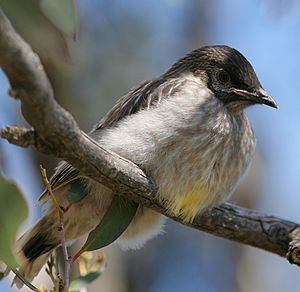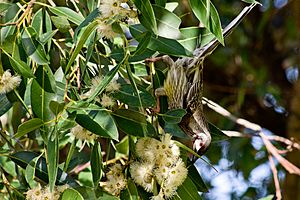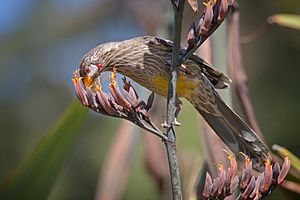Red wattlebird facts for kids
Quick facts for kids Red wattlebird |
|
|---|---|
 |
|
| Conservation status | |
| Scientific classification | |
| Genus: |
Anthochaera
|
| Species: |
carunculata
|
 |
|
| Distribution map of the red wattlebird | |
The red wattlebird (Anthochaera carunculata) is a type of passerine bird that lives in southern Australia. It is about 33 to 37 centimeters (13 to 15 inches) long. This makes it the second largest type of Australian honeyeater.
Red wattlebirds have mostly grey-brown feathers. They have red eyes and special pinkish-red wattles on each side of their neck. These wattles are fleshy growths. They also have white streaks on their chest and a bright yellow patch on their lower belly. Male and female red wattlebirds look very similar. Young birds have smaller wattles and browner eyes.
This bird lives in southeast Queensland, New South Wales, Victoria, South Australia, and southwest Western Australia. You can often find them in open forests, woodlands, and even in city gardens and parks. Red wattlebirds are loud and easy to spot. They usually stay in trees to find food, but sometimes they look on the ground. They are one of the biggest birds in the world that eat nectar (sweet liquid from flowers). They also eat insects. Red wattlebirds can be very protective of their space and food, sometimes acting aggressive towards other birds. They build cup-shaped nests in trees and usually raise one or two groups of babies each year. Even though their numbers have gone down in some areas because of land clearing, they are not considered endangered.
Contents
About the Red Wattlebird's Name
The red wattlebird was first described in 1790 by a surgeon named John White. He called it the "wattled bee-eater." Later, another naturalist, George Shaw, gave it the scientific name Anthochaera carunculata. The word carunculata comes from a Latin word meaning 'a small piece of flesh,' which refers to its wattles. The name Anthochaera comes from ancient Greek words meaning 'flower' and 'enjoy,' because these birds love flowers.
People have many different common names for this bird, like gillbird, barkingbird, and what's o clock. Some Indigenous Australian groups gave the bird names that sound like its calls, such as wodjalok and durdal.
There are three slightly different types, or subspecies, of the red wattlebird. They look very similar, so it's hard to tell them apart just by looking.
- A. c. carunculata: Found in southeast Australia.
- A. c. clelandi: Lives on Kangaroo Island in South Australia. It has darker feathers and a longer beak.
- A. c. woodwardi: Found in southwest and south-central Australia. It is a bit smaller and has a brighter yellow patch on its belly.
Scientists have studied the DNA of the red wattlebird. They found that its closest relative is the yellow wattlebird, which lives in Tasmania.
What Does a Red Wattlebird Look Like?
Both male and female red wattlebirds look alike and are similar in size. Adults are usually 33 to 37 centimeters (13 to 15 inches) long and weigh about 100 to 120 grams (3.5 to 4.2 ounces). They are one of the biggest birds in the world that eat nectar.
Their head and the back of their neck are dark brown with lighter streaks. They have a white patch near their eyes, bordered by a dark stripe. Their throat is dark brown with white streaks. The most noticeable features are their bright orange-red eyes and the pinkish-red wattles that hang from the sides of their neck. They also have white streaks on their chest and belly, with a bright yellow patch near their tail. Their legs and feet are pink, and their beak is black and curves downwards.
Like other honeyeaters, the red wattlebird has a special long tongue. It can stick its tongue far out of its beak. The end of the tongue is like a brush with many tiny bristles. These bristles help the bird soak up nectar from flowers, just like a sponge!
Young red wattlebirds look a bit different. Their wattles are much smaller, their eyes are brown, and they have less yellow on their belly. As they grow, they start to look more like adults.
Red Wattlebird Calls
Red wattlebirds are very noisy birds! They make many loud sounds. Often, a male and female bird will call together, especially when they are near food. The male makes a loud cackling sound, and the female makes a whistling call. The male's cackle sounds like a squawk, cough, or hiccup. They use this call when they are looking for food or telling other birds to stay out of their territory. Both sexes also make a single "chock" sound, which is thought to be a way for them to keep in touch with each other. These calls can be heard from far away.
They also have two types of alarm calls. They use these calls when they are trying to scare away other animals that might be a threat, like predators. One alarm call is harsh and loud, and the other is a lower-pitched, quick call.
Where Red Wattlebirds Live

Red wattlebirds live in many parts of Australia, from southeast Queensland down through New South Wales, Victoria, and South Australia, and across to southwest Western Australia. You won't find them in Tasmania; the yellow wattlebird lives there instead.
These birds usually stay in the same area for most of the year. However, some may move to different places to find flowering plants, especially in winter. For example, in Perth, many red wattlebirds arrive in winter to feed on flowering banksias.
Their favorite places to live are open forests and woodlands, especially those with many eucalypt trees. They also like forests that have lots of shrubs and grass underneath the trees. In cities, they are common in parks, gardens, and even golf courses. They can sometimes be found in orchards and vineyards too.
Red Wattlebird Behavior
Red wattlebirds are active and loud. You might see them alone, in pairs, or in small family groups during the breeding season. In winter, they can gather in much larger groups, sometimes hundreds of birds! They fly straight or with a slight up-and-down motion, flapping their wings quickly. On the ground, they hop around, often with their tail pointing slightly upwards.
These birds can be quite aggressive and territorial. They protect their nests and food sources from other birds. They might call loudly, snap at tails, or even fly at other birds. Sometimes, they will fight with other red wattlebirds or large honeyeaters in the air. They can also chase away much larger birds like Australian magpies, currawongs, and even small birds of prey.
Reproduction and Life Cycle
Red wattlebirds breed throughout their range, usually from July to December. They can have one or two groups of babies each year.
They build a cup-shaped nest from sticks and leaves. They line it with bark, grass, and hair. The nest is usually placed in the fork of a tree branch, often a eucalypt, about 2 to 16 meters (6.5 to 52 feet) above the ground.
A female red wattlebird usually lays two or three eggs. The eggs are pinkish with pale brown and lavender spots. Both parents usually help to incubate the eggs, which means keeping them warm until they hatch. The eggs hatch after 16 to 21 days.
When the chicks are born, they are almost naked with a little grey fluff. The female bird mostly keeps them warm, but the male helps too. Both parents feed the young birds, and sometimes even older, immature birds will help. The chicks' eyes open when they are about 7 days old. They leave the nest 15 to 20 days after hatching. Both parents continue to feed them for another 2 to 3 weeks. Young birds are fed insects like beetles and flies.
What Red Wattlebirds Eat
Red wattlebirds mainly eat nectar from flowers. They usually look for food in trees, climbing along branches and poking their beaks into flowers. They prefer flowers that produce a lot of nectar, like those from eucalypts, banksias, and grasstrees. They often choose flowers that are easy to get nectar from.
Besides nectar, they also eat insects and other small creatures. They often catch insects while flying, which is called "hawking." They also eat berries and other fruits. One study found that they spend twice as much time eating nectar as they do eating insects.
Red wattlebirds often feed alongside other birds like New Holland honeyeaters and rainbow lorikeets. However, they will often chase other nectar-eating birds away from a large group of eucalypt flowers. They can be quite aggressive when there is a good amount of nectar available, trying to keep it for themselves.
Their special brush-tipped tongue helps them drink nectar. It has many tiny bristles that soak up the nectar through a process called capillary action.
Threats and Conservation
Red wattlebirds are affected when their habitats are cleared or changed by humans. Even so, they are listed as "Least Concern" on the IUCN Red List. This means they are not currently endangered because they live in a wide area, have a large population, and their numbers are not dropping quickly.
Sometimes, red wattlebirds are killed by cats and dogs, or hit by cars. In the past, they were sometimes hunted for food or sport. They were also seen as pests in vineyards and orchards because they would eat grapes, stone fruit, and other fruits.
Red wattlebirds have been kept as pet birds in aviaries. They are not hard to care for, but they can be very aggressive towards other birds in the same cage.
Images for kids
See also
 In Spanish: Mielero carunculado para niños
In Spanish: Mielero carunculado para niños







